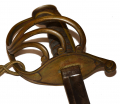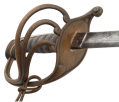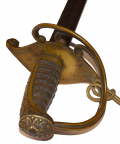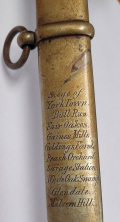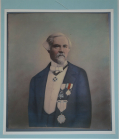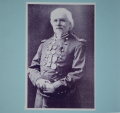site search
online catalog
MEDAL OF HONOR FOR “EXTRAORDINARY HEROISM” – 1861 PRESENTATION SWORD OF LT. CHARLES JOSEPH MURPHY, 38th NEW YORK, MEDAL OF HONOR FOR BULL RUN, ESCAPEE FROM LIBBY, VOLUNTEER AIDE TO MEDICAL STAFF IN THE PENINSULA CAMPAIGN
$9,500.00
Quantity Available: 1
Item Code: 1052-1131
Shipping: Determined by Method & Location of buyer
To Order:
Call 717-334-0347,
Fax 717-334-5016, or E-mail
This non-regulation officer’s sword bears an 1861 presentation on the obverse scabbard, “Presented to/ Lieut. C.J. Murphy, / by his friends / 1861” and a list of battles on the reverse including Bull Run and battles in the Peninsula Campaign. The officer’s name (even allowing for officers omitting a middle initial in some records,) rank, date and engagements fit only one officer- Lieutenant Charles Joseph Murphy, who received the Medal of Honor for actions at First Bull Run and served as volunteer aide for medical staff during the Peninsula Campaign while awaiting a commission in the regular army, recommended by several high ranking officers, and endorsed by Lincoln on March 15, 1862.
The sword is a non-regulation pattern using a grip with backstrap and guard with knuckle bow and three-rounded side bars, with a metal scabbard. We see no maker or retailer marks, but the hilt is similar to the French M1854 Cent Gardes style cavalry officer hilts sold by Schuyler, Hartley and Graham, though omitting a disk with eagle and flags applied the side bars, and using a backstrap similar to those employed on hilts combining elements of the Chasseur and Navy officer hilts, and the metal scabbard is brass rather than steel, likely gilt to match the hilt.
The hilt has a slightly domed round pommel cap with cast and chased floral elements- a rosette and 8-leafed petal with raised dots between the tips and a stippled ground. The grip has a backstrap with raised five-pointed star in a wreath under the brim of the pommel cap, crossed leafy branches with berries and a tall somewhat abstract palmette, ending with a narrow ferrule at the guard. The grip is regulation gray sharkskin, bound with three strands of brass wire, the central one loosely twisted. The counter guard, kuncklebow and three branches are undecorated. The quillon is tall and ends in a scroll imitated in the curled ends of branches as they join the narrow pointed oval counterguard. The underside of the guard has a deep border line. The blade pad is gone.
The blade is slightly curved, single-edged, but with a false edge extending forward from the end of the central wide fuller. A narrow secondary fuller runs along part of the back edge. Both sides have etched panels starting above the ricasso with a palmette, followed by stand of arms with furled banners on pikes, drums, cannon barrels, shields, etc. which are partially entwined by scrolling floral elements that continue on their own, followed by a second martial panel and terminating with another series of floral scrolls and leafy vines.
The scabbard is brass, lacking a throat, but with carrying rings on simple bands, and the drag in place. The sword knot with the sword is gold bullion cord with rounded knot and tassels and may be postwar- the owner had later service in the National Guard and at least one photo shows him in later uniform with a sword that could be this one.
The hilt, certainly gilt originally, shows largely as a mellow, untouched aged brass. The cast and chased element are sharp and well defined. The grip is very good, with wire in place and the sharkskin showing good gray color and surface. The blade has a good edge and point. It has oxidized and it uncleaned, showing largely as gray, but the etching is visible. The scabbard has an uneven yellowish tint indicating it was likely gilt to match the hilt. It shows scratches, some rubs, and some reddish brown spots on the obverse, but no significant dents or dings. The drag is dark and appears to be iron or steel.
The scabbard is inscribed in line with the scabbard on the obverse between the mounts, Presented to/ Lieut. C.J. Murphy, / by his friends / 1861 in script and block letters. On the reverse in the same location it is inscribed horizontally, Siege of / Yorktown / Bull Run / Fair Oakes / Gaines Mills / Goldings Farm / Peach Orchard / Savage Station / White Oak Swamp / Glendale / Malvern Hill.
“Bull Run” is out of chronological order in the list, but the difference in style of the engraving and that the other battles took place in 1862 clearly indicate Murphy himself had the battles engraved later as a record of his wartime service both as a commissioned officer in the 38th New York and his subsequent service on the peninsula as a “volunteer aide” before he gave up on obtaining a commission in the regular army.
The full citation for Murphy’s award reads: The President of the United States of America, in the name of Congress, takes pleasure in presenting the Medal of Honor to First Lieutenant & Quartermaster Charles Joseph Murphy, United States Army, for extraordinary heroism on 21 July 1861, while serving with 38th New York Infantry, in action at Bull Run, Virginia. First Lieutenant Murphy took a rifle and voluntarily fought with his regiment in the ranks; when the regiment was forced back, voluntarily remained on the field caring for the wounded, and was there taken prisoner.
Murphy was born in 1832 to a family of Irish background, who emigrated to New York from England shortly before or shortly after his birth (he is listed as both born in England and in NY.) By his own account he had an active disposition, serving at a very young age in the Mexican War- by 1902 he was the second youngest surviving veteran of that war. He appears to have served in Burnet’s 1st NY Regiment, though his reminiscences tend more toward the general, but that name appears in New York records and he mentions being in Puebla in 1847 a recounts a horrendous five-day voyage from Brazos Santiago to New Orleans as one of 100 invalid soldiers crammed in the hold a steamer carrying 1,800 other soldiers, along with trophy Mexican artillery and lances. He made it back to New York, but did not stay long, sailing to California in 1849, earning a later membership in a pioneer society, and sometime in the early 1850s was on a voyage to Shanghai- we hope on fast clipper ship rather than a slow boat. By 1855, however, he was back in New York, living with his parents and six siblings, engaged in bottling with his father, though he may struck out on his own soon after in the liquor and wine business. He married that year in Rochester, raising twelve children during his lifetime, but was back in New York City before the war, his business netting him $6,000 a year by the time the war began by his own account.
He had been a member of the 7th NYSM and was an officer and founder in the Scott Life Guard, which was the nucleus of the 38th New York, though they ended up settling for “2nd Scott’s Life Guard” as an alternate designation. He enrolled to serve two years at age 29 in New York City, and mustered in as First Lieutenant and Quartermaster on June 8, the post likely a tribute to organizational talents acquired in business, and the regiment left state for Washington on June 19. He later received his commission dated July 4 giving him rank as 1st Lieutenant from May 27, likely the real start of his duties, and as Quartermaster from June 1, but was not mustered, most likely because the actual commissions arrived after his capture and imprisonment.
At First Bull Run the regiment was in Howard’s Brigade and lost 19 men killed or mortally wounded, another 56 officers and men wounded, and 56 more captured. Not only did Murphy enter the fight though he could have remained in the rear, and was reported fighting in the ranks, he remained on the field after the unit fell back in order to aid the wounded and was captured along with the regiment’s Assistant Surgeon. Nicknamed “doctor” by the men and mistaken for a surgeon by his captors, he nevertheless refused a parole and was sent to Libby Prison, where he continued to aid the wounded and sick. By September, however, the place had lost its charm and in company with two other officers he escaped by passing guards wearing an improvised red rosette indicating a surgeon on parole on September 5, 1861, and spent a grueling nine days clambering through woods and crossing streams before reaching Washington on September 14, a feat that earned him a ten-day leave, a good deal of newspaper coverage, and an interview with Lincoln.
Several high-ranking officers recommended him for promotion and a post in the regular army, for his bravery on the battlefield, selflessness in remaining on the field to aid the wounded, and resolve in escaping. In expectation of this, and still suffering from the effects of imprisonment and escape, he resigned his commission in the 38th on November 5, to push forward his claim, including a November 25 testimonial from six surgeons and assistant surgeons, with an approval by General Shields, which finally bore fruit with an endorsement by Lincoln himself on March 15, 1862.
Murphy was disappointed, however, to find that he would have to wait in line with others so recommended for a vacancy in the regular army, “and not wishing to idle my time away in Washington waiting, and always been accustomed to an active, busy life, I immediately took my departure for the White House on the Pamunkey River, which was the base of operations for Gen. McClellan's Army of the Potomac, and served as a volunteer aid, without rank or pay, all through that unfortunate campaign, from the Battle of Fair Oaks to the last of the Seven Days' Battles at Malvern Hill.”
Other testimony indicates he helped set up the first tented field hospital on the army’s arrival at Harrison’s Landing, helped transport a load of wounded men back to Fortress Monroe on the Hospital Transport John Brooks on July 2, and even arranged for shipload of ice to be sent to the army, suffering in the heat back at Harrison’s Landing, but which could not be delivered before McClellan pulled out. Although apparently giving up hope or interest in another commission, he had one more humanitarian gesture to make for the military: riding out from Washington at the end of August with a load of whiskey to aid the wounded from Second Bull Run.
Murphy seems to have suffered some health issues from his activities in the field, and he may have suffered losses in the New York City draft riots, but he continued to pursue, “an active and busy life,” being a mix of business, participation in the National Guard, rising to the rank of Colonel, membership in both Civil War and Mexican War veteran groups, authoring both a pamphlet of reminiscences and a “condensed history” of the Mexican War. One his largest endeavors, which earned him the gratitude of American farmers and honorary commissions to represent states like Iowa and Nebraska in Europe was his effort to broaden the markets for American cereals, earning him a nickname as the “Corn Propagandist,” one his literary productions being a pamphlet touting its virtues and setting out 150 ways to cook it. Needless to say, being in the wine business, he also received credit for introducing California wines into European markets- though perhaps with uncertain success. He died in 1921, reportedly in New Jersey, and was interred in New York.
All in all, Murphy is an interesting character who seems to have embodied the Teddy Roosevelt ideals of an active life, combining his military experiences, which he was proud to commemorate on the back of his sword scabbard, with his humanitarian and philanthropic interests.
Wartime swords carried by Medal of Honor winners do not come along often. [sr][ph:L]
~~~~~~~~~~~~~~~~~~~~~~~~~~~~~~~~~~~
THIS ITEM, AS WITH ALL OTHER ITEMS AVAILABLE ON OUR WEB SITE,
MAY BE PURCHASED THROUGH OUR LAYAWAY PROGRAM.
CLICK HERE FOR OUR POLICIES AND TERMS.
THANK YOU!
Inquire About MEDAL OF HONOR FOR “EXTRAORDINARY HEROISM” – 1861 PRESENTATION SWORD OF LT. CHARLES JOSEPH MURPHY, 38th NEW YORK, MEDAL OF HONOR FOR BULL RUN, ESCAPEE FROM LIBBY, VOLUNTEER AIDE TO MEDICAL STAFF IN THE PENINSULA CAMPAIGN
For inquiries, please email us at info@horsesoldier.com
Most Popular
Historical Firearms Stolen From The National Civil War Museum In Harrisburg, Pa »
Theft From Gravesite Of Gen. John Reynolds »
Selection Of Unframed Prints By Don Troiani »
Fine Condition Brass Infantry Bugle Insignia »
British Imported, Confederate Used Bayonet »
Scarce New Model 1865 Sharps Still In Percussion Near Factory New »
featured item
ID’D P1855 MOUNTED SERVICES MUSICIAN’S SHELL JACKET – WILLIAM OSWALD, 4th PENNSYLVANIA CAVALRY
William Oswald resided in Northampton County, Pennsylvania when he enlisted on August 15th, 1861. On that same day, he mustered into Company “A” of the 4th Pennsylvania Cavalry as a Bugler. Initially, the regiment was organized at Pittsburgh,… (2023-2635). Learn More »
site search
Upcoming Events
May 16 - 18: N-SSA Spring Nationals, Fort Shenandoah, Winchester, VA Learn More »







